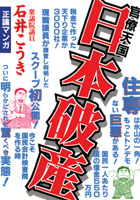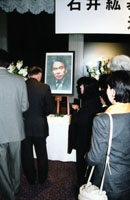Upfront: Who Killed Koki Ishii?
Back to Contents of Issue: April 2004
|
|
|
|
by David McNeill |
|
|
"I was trying to talk but he was so withdrawn and serious," says Tatiana. "I thought maybe he wanted to tell me something, but he stayed silent so I went to bed. When I left the house the following morning, he was just staring out the window at me."
The next time Tatiana saw her father later that day, he was lying in a hospital morgue, his heart stopped by a 12-inch sashimi knife. At 10:30 a.m., as he walked toward his state-provided car near his house on a quiet, middle-class Tokyo cul-de-sac, a man wearing a dark bandana jumped out from behind a bush, skillfully buried the knife in Ishii's chest and fled, leaving Natalia at the window screaming.
Ishii's alleged killer, Hakusui Ito (48), a well-known uyoku, or ultra-nationalist, surrendered to the police a day later and is now on trial. Ito had hung around Ishii's constituency office in Setagaya for years trying to sell overpriced rightist books and extort "political donations" -- a common uyoku practice. When Ishii refused a request to pay Ito's rent, prosecutors say the rightist killed him.
Case closed, say the police -- but Ishii's family and friends are far from convinced.
"Days before he died he was telling people he had uncovered something that could sink the Koizumi administration," says Tatiana. "That's why he looked so worried."
Soon after the murder, a number of men came to Ishii's Diet office and told his elderly secretary they were with the police. The men took some of Ishii's papers without signing a chit for the documents. The papers have never been recovered.
The family is not alone in believing that there is more to Ishii's death than revenge by a deranged rightist. Jour-nalist Nori Imanishi, who met the politician in the Diet members' office building just before his death, says Ishii told him and others that he had "discovered something terrible." The timing of his murder, Imanishi says, is "very suspicious."
Outgoing Social Democrat (SDP) parliamentarian Nobuto Hosaka wonders aloud why the police and Ishii's fellow parliamentarians have been so slow to clear up doubts about the murder: "The leader of Ishii's own party, Naoto Kan, said that he would investigate the killing. But he hasn't asked a single question in the Diet about it, nor has anyone from the DPJ." Hosaka is the only Diet lawmaker on record to have publicly questioned the facts of the case at length.
From 1992 to 2002, when Ishii was in office, Japan's public debt exploded by over JPY342 trillion (over $2.5 trillion), or nearly 70 percent of GDP, leaving it with "a deeper public-debt crisis than any other nation in modern history," says long-time Japan-watcher Gavan McCormack. Japan's huge construction machine, and the political corruption and secret deals that grease it, so alarmed Ishii that he spent years trying to change the system, poring over thousands of government documents, tabling hundreds of hours of Diet debate and eventually setting up his own anti-corruption task force within the DPJ, dubbed the "G-Man Squad" after the Prohibition-era FBI gangbusters in the United States.
What Ishii had discovered was a secret budget paying out to corrupt politicians and other figures. "He would work late into the night in his Diet building office," Tatiana recalls. "The heating would go off and the building supervisors would call and ask when he was going home. My father joked it was all deliberate, to stop politicians from working."
Ishii was especially frustrated, say his family and friends, by the bureaucrats who control public policy and tax allocation in Japan, once telling a recalcitrant mandarin to "translate documents into English," because he found the Japanese explanation so confusing. Ishii had little faith that LDP insider Junichiro Koizumi would turn the country around. "Koizumi's reforms were like putting a band-aid on the hand of a dying patient," says Tatiana.
His family and friends believe that Ishii's relentless pursuit of corruption and the secret state made him powerful political and possibly underworld enemies. Japan's yakuza, whose members control a huge chunk of the construction industry and have a long history of collusion with ultra-rightists and senior LDP political figures (see sidebar), will have shed no tears over his death.
Natalia is unequivocal about her suspicions: "I think somebody offered Ito money to kill my husband." She saw the murder from the front window of their house and believes it had been planned "for a long time," pointing to a series of odd events and inconsistencies surrounding her husband's death.
On the day of the murder, at 9:15 a.m., when Koki Ishii was still in bed, a man posing as a gardener called at the Ishii house. Tatiana, who talked to the man on the intercom, says he "spoke and walked like a yakuza," and she and her mother believe this was Ito's accomplice checking to confirm whether Ishii was still at home. (The police claim Ito acted alone.)
Ishii's official driver made no attempt to help Ishii when he was struggling for life only ten feet away because, he says, he "panicked." As Ishii lay dying, his wife screamed at the driver, who was already talking on his cellphone to call an ambulance. He said, "I'm calling," but never did anything to help. The Ishiis say his actions were slow and deliberate, like a person buying time.
Ito said he fled to a mountain resort called Takao, about an hour from Ishii's home. But why did nobody witness him and what must have been his bloodstained clothes? The family believes he waited in a local safe house before being persuaded to go to the police, a theory backed by Mainichi Shimbun journalist Shuzo Masuda. "There are lots of rumors that Ito stayed in the house of another politician or yakuza associate," Masuda says.
When Ishii's belongings were returned to his family, his normally bulging briefcase was almost empty. Most mysteriously, Ishii's diary also disappeared.
Hosaka raised some of these questions in the Diet last October, but they were brushed aside by a public security official. "Nobody wants to get to the bottom of this," he says. "The police have not investigated whether there was an accomplice or getaway car. The judges won't accept any evidence that suggests the involvement of an accomplice. The DPJ did well in the last election, thanks partly to Ishii's work, but they don't want any controversy. The press doesn't want to dig it up. It's more comfortable for everyone to let this lie."
Everyone except Ishii's family, who have not washed Koki Ishii's car since he collapsed in front of it over a year ago. "There may be fingerprints on it and I'm told they can survive for 14 years," says Tatiana. "I'm waiting for the police to come back and do a proper investigation."
@
|
|
Note: The function "email this page" is currently not supported for this page.


 Koki Ishii lived in a house full of women: his Russian mother-in-law, his wife Natalia and his daughter Tatiana. They were quick to sense his moods. So on the night of Oct. 24, 2002, they knew that the 61-year-old politician was worried sick.
Koki Ishii lived in a house full of women: his Russian mother-in-law, his wife Natalia and his daughter Tatiana. They were quick to sense his moods. So on the night of Oct. 24, 2002, they knew that the 61-year-old politician was worried sick.
 A former socialist and scourge of Japan's ruling Liberal Democratic Party (LDP), Ishii had made a name for himself as a tough, anti-corruption politician who had gone to war with the so-called doken kokka, or construction state. In books such as Nihon Hassan (Bankrupt Japan), Ishii wrote that Japan was rotting from the inside out, its economic vitality sucked dry by a coalition of industry bosses, LDP politicians and bureaucrats who are addicted to construction projects and the public money that funds them.
A former socialist and scourge of Japan's ruling Liberal Democratic Party (LDP), Ishii had made a name for himself as a tough, anti-corruption politician who had gone to war with the so-called doken kokka, or construction state. In books such as Nihon Hassan (Bankrupt Japan), Ishii wrote that Japan was rotting from the inside out, its economic vitality sucked dry by a coalition of industry bosses, LDP politicians and bureaucrats who are addicted to construction projects and the public money that funds them.
 Natalia Ishii says she dialed the emergency services number 10 times but there was no reply. Police said the first call for an ambulance was received from a neighbor at 10:36 a.m., but it was subsequently discovered that it was only transferred to ambulance services at 10:41 a.m. The ambulance did not arrive until after 11:00 and struggled through police cruisers to reach Ishii's side. Well over 30 minutes had elapsed before a medical crew could get to Ishii.
Natalia Ishii says she dialed the emergency services number 10 times but there was no reply. Police said the first call for an ambulance was received from a neighbor at 10:36 a.m., but it was subsequently discovered that it was only transferred to ambulance services at 10:41 a.m. The ambulance did not arrive until after 11:00 and struggled through police cruisers to reach Ishii's side. Well over 30 minutes had elapsed before a medical crew could get to Ishii.




